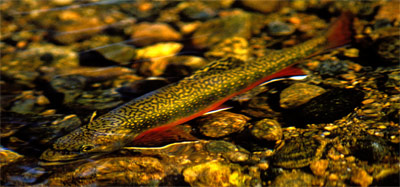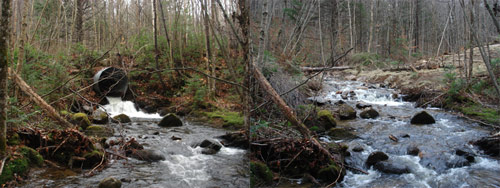
In southern Appalachia, they still call brook trout the “hemlock trout” because they’re mainly found in the cold water and deep shade of the hemlock forest. These spectacularly colorful fish are part of the genus Salvelinus, which makes them descendants of sea-going arctic char. In the Northeast they adapted and thrived, dominating the aquatic food chain where waters ran cool and fast. In precolonial days, trees a hundred and fifty feet tall kept all but the widest streams in perpetual shade, and when those trees tumbled into the waterway, as they inevitably did, they created enormous log jams, waterfalls, plunge pools, and back waters. The trout themselves were routinely two feet long and weighed five pounds. They would migrate from spawning grounds in the smallest streams to deep water refuges in large rivers; sometimes they’d travel all the way to the sea. The trout were as magnificent as the trees themselves.
Land clearing, introduction of non-native species such as brown and rainbow trout, and in certain areas the hemlock wooly adelgid, a non-native insect pest that kills hemlock trees, have drastically reduced the native brook trout population in both size and number, extirpating them in all but the smallest and coldest streams. Regulations have since been put in place to protect their fragile habitat, with limits on the cutting of streamside trees and strict guidelines for stream crossings.
It can come as a surprise, then, to find an excavator at work in a New England stream channel, apparently doing just the sort of thing that the laws were designed to prevent.
River moonscape
I followed Trout Unlimited’s Jim MacCartney on a rainy morning last fall as he wove through a thicket of young fir toward the bank of Nash Stream in northern New Hampshire. He’s T.U.’s river restoration specialist, and Nash Stream is one of the most degraded runs of brook trout habitat in the Northeast. After fifty years of log drives and a hundred years of intense timber harvesting, a 40-foot-tall dam (left over from the log-driving days) suddenly gave out during a wet May in 1969; almost instantly, a 236-acre pond raced down the nine-mile run of the Nash Stream to the Upper Ammonoosuc.
“There’s a rowboat way off in the woods with a tree growing through it,” says MacCartney, noting a relic from that fateful flood. Today, we are standing in the field of stones and cobble that forms the stream’s bank these days. Nothing grows between the stones but stunted white birch, poplar, and lichen. Although the trees are upwards of 40 years old, they are just wrist-thick. “We call it a moonscape,” MacCartney says. The flood had washed away the previous cover of trees and soil. In the days that followed, the paper company that owned the land ran bulldozers up and down the broad wash of boulders and cobble. The channel was deepened, straightened, and deprived of structure while the adjacent roads were rebuilt. Timber cutting continued, and continues on a limited basis today. The State of New Hampshire purchased the land in 1988, and now nearly all of the Nash watershed is part of the 40,000-acre Nash Stream State Forest.
Part of the management plan that the state subsequently developed calls for the restoration of in-stream habitat, and while the Nash may be an extreme example of stream alteration, there are plenty of other examples of streams that are still recovering from the logging practices of a century ago. The thought is that experimental restoration work done here, where a permanent conservation easement assures long-term protection, could be useful elsewhere. A study of the upper Connecticut, for example, just 15 miles distant, revealed that about 30 percent of the river has been straightened in the past in order to facilitate the annual drive of 40-foot logs. Habitat loss seemed small potatoes during the legendary log drives of the late nineteenth and early twentieth centuries, when men were crushed and drowned as the northern forest was harvested to build a nation. Now the river writhes and cuts into banks trying to find equilibrium again. On the Connecticut, as on the Nash, boulders had been dynamited and snags removed from the channel.
I first met Jim MacCartney about a dozen years ago when he was New Hampshire’s “River Coordinator,” a seemingly self described job. A large part of the job was reviewing permits for bank stabilization and stream crossings. The Rivers Management Protection Act called for the use of “natural” materials when possible, and while applicants were often willing to go along, many engineers simply didn’t know how to utilize such materials. They’d been schooled to stabilize river banks and bridge abutments with conventional materials such as a rip-rap – blasted rock with sharp angles that fit tightly together. Today, we know that these uniform rock faces increase water velocity and reduce in-stream habitat. We also know considerably more about fluvial geomorphology, which studies dynamic interactions of moving water and land. At the time, the term had hardly even been coined, let alone accepted, and few understood the complexity of habitat in an upland stream. Now, as a “river restoration specialist,” MacCartney is once again defining his own field of work.

The Slow Dance
The importance of streamside trees to aquatic habitat is well known, and reflected in timber-harvesting directives. Trees provide shade, keeping water cooler, and their roots help hold the banks in place. They provide nutrients in the form of dead leaves, and their overhanging branches provide a platform from which clumsy bugs can slip and topple in. But the trees themselves occasionally topple in, too, playing an important role in habitat dynamics. MacCartney wants to demonstrate this as a component of his restoration project.
In a naturally dynamic stream, trout and trees do a slow dance together, as the fallen trees gradually make their way toward the sea. Deep water refuges alternate with shallows, quick water with slow, and sedimentation patterns constantly shift with the movement of woody material. New habitat is created and old habitat is destroyed with each high-water event, but a natural system like this depends upon new material being added each year. Right now in the Nash watershed, beavers are doing a pretty good job of that in the upstream reaches; they’re attracted to the brushy post-apocalyptic growth of small aspens, alder, and birch. “We’re learning to work with them,” says MacCartney, who sees his role as that of a facilitator, encouraging natural processes.
But there have to be big trees in the mix, too, so MacCartney has an excavator pull them out, roots and all, from a few hundred yards back in the woods and bring them to the stream. He usually anchors them in the channel, often by wedging the top among standing trees on the opposite bank and laying some big boulders around the root wad on the near bank. He doesn’t use the easier “chop and drop” technique on a big stream like this, because root wads, levered vertically in the channel, play such an important role in diverting flow and catching material. He takes his cues on what to build from his experiences working on less-disturbed river beds, looking to the natural landscape around him and taking advantage of what is already there to create a self-maintaining system.
I followed him up an old tote road to where he had been working earlier that summer. We broke through the brush to the stream itself, where it was running quickly and curving around a pile of woody material that had recently accumulated. The water had a smooth, muscular look where it pitched over a log and passed a deep refuge. It looked just the way a wild stream should – tree stems with their root wads fanning out above collections of smaller material – except that many of the stems had blue plastic tags on them. This was a reach of the stream that was hard to access with his equipment, so MacCartney had placed the trees in the river about a mile upstream a few months earlier and was now tracking their movement with each high-water event, just as elsewhere on the stream that same day fishery biologists were tracking the movements of the trout themselves.
“Mobile wood has downstream risks,” says MacCartney, “and this is a good place to experiment with it. Are the materials moving in the way we expected? How much stays in place, and under what flow conditions?” MacCartney nailed his blue tags on 29 trees before the excavator placed them in the stream. Two months later, a large coastal storm had dumped over five inches of rain in two days. By the time of our visit, he had found 27 of the trees. “Some trees had moved in ways I hadn’t expected, but with experience, this technique can be used in more developed areas.”
MacCartney uses the excavator to put big boulders back into the stream bed, too, and there are stockpiles of them, each weighing a ton or more, out by the road waiting for next year’s work. He places them carefully, making them look natural by bedding them down yet keeping them high enough to “recruit” more woody material washing down; he uses the term as though the stones and wood are living things. If there are already two boulders in the stream, he may place a third to form the apex of what becomes a weir. There is a lot of technical skill here, but what begins to impress me even more is the art. Nowhere is this more apparent than where he has rebuilt a stream crossing. The paper company had crossed the Nash and its tributaries by the most expedient means, often using old paper rollers or boilers from the mill as culverts. These were frequently “perched,” that is, with the downstream opening too high, resulting in a waterfall that denied upstream access by brook trout and other species that use small tributaries to spawn.
In some cases, where culverts were used to access parts of the forest that were no longer being harvested, the culverts had been removed, the stream bed restored using natural local materials, and the access blocked. But in two cases, large four- and six-foot diameter culverts were replaced by bridges, which are far more expensive but when properly done have very little impact on the stream. The hardest part was convincing the engineers to use only “subangular” local rounded stones instead of rip-rap, while still building sufficient strength and flood resistance into the bridge. The biggest boulders were set against the abutments. Then a “natural” stream bed was constructed by replicating the reaches upstream and down, using a variety of stone sizes, gravel, and sand. The smaller stones were placed by hand, reminding me of a Japanese garden.

Is It Worth It?
After we inspected one of the bridges, we visited with a young biologist back out at the gravel tote road. She was netting and cataloging fish above the bridge. Along with the brook trout, she was also catching slimy sculpin. This little fish is about as attractive as the name implies, but while it is unlikely to make the cover of the Orvis catalog, it is an indicator of high-quality habitat. Before the culvert was replaced, biologists had counted no sculpin and just 29 trout in the reach above it. On this day, the count was 29 sculpin and over 100 trout. There were similar results elsewhere in the watershed, where crossings had been replaced or removed.
The result is, in a word, beautiful, but it does not come cheaply. This bridge, with steel beams topped by a treated lumber deck, cost $120,000. It is the most expensive item in a total restoration budget of over a million dollars. The largest portion of these expenditures, $420,000, comes from a fund set up as part of the relicensing terms for the Fifteen Mile Falls hydroelectric complex a few dozen miles downstream on the Connecticut. The purpose of that fund is to provide compensatory “off-site” mitigation of the habitat impacts of the hydro project, while allowing the project to continue operations. The New Hampshire Department of Environmental Services kicked in an additional $320,000, followed by $85,000 from the New Hampshire Fish and Game Department, the Natural Resource Conservation Service’s “WHIP” program at $75,000, plus tens of thousands from various chapters of Trout Unlimited and other foundations, in-kind support from New Hampshire Fish and Game, the U.S. Forest Service and New Hampshire’s Division of Forests and Parks, as well as the Groveton Trail Blazers snowmobile club and even a few hundred dollars from the Unitarian Universalist Church.
Is it worth it? It is impossible to put a short-term dollar value on an ecosystem, especially when human values keep changing. This project is buying new knowledge, too, but these results can be equally hard to price. On my way out, I stopped by the remains of a “squirt dam” on the lower part of the Nash, where logs had been held and led through a narrow raceway on their way to the mill. Amidst the ruins of the log-crib dam, one huge, primordial, forty foot log had been cast up by the flood waters. Surely a hardwood (I suspected yellow birch) and felled by axes, it may have lain buried in the sediments for a hundred years. Within a few more miles, I passed the paper mill in Groveton, which had just closed weeks before, putting hundreds out of work. Nobody there knows what is coming next, if anything at all. That old remnant forty-foot log and the desolate mill buildings neatly bracket an industry’s rise and fall.
Now, long-term ecological sustainability is the goal. Many of the trout being netted that day were just three or four inches long, but that’s just the right size to benefit from the work MacCartney and his crew are doing on some of the smaller Nash tributaries, and the sort of work landowners, woodsmen, and fish fanciers can do themselves without expensive excavators. Again, it is simply a matter of artfully placing cut trees in the stream, where they will change the flow, create velocity refuges, trap smaller debris such as twigs and leaves, and change the patterns of sedimentation. On these small streams, where the logs are light enough to carry by hand, the material is meant to stay in place, with crotches straddling standing trees and ends anchored in stone. It should mean more fish ascending to successfully spawn, and more mature adults back in the main stem. Here, too, small streams where this work has been done are marked off in meter lengths so that population changes can be inventoried.
This may seem insignificant on its own, just a few more three or four-inch trout in a few meters’ reach of an upland stream. But human habitat is constantly shifting, too, with its own set of economic and social interdependencies, which we are only beginning to understand. Now, change is coming even faster than when the glaciers last melted, and trout and trees reclaimed this place. With the Nash Stream watershed in public hands, its value is rising, not just the recreational and timber value but also the property values for the ninety or so camps, many of which had lost their waterfront on that wet night in May of 1969. There are plans for the paper mill downstream, too, such as a biomass-fueled, hydroponic growing facility. Nothing is certain, but there are some good reasons for optimism as men, trout, and trees continue to adapt and evolve together.

Clean Water
River restoration and streamside planting projects are happening all over the Northeast. Besides this good news on the habitat front, it’s also worth noting how water quality has improved in most places over the last 30 years.
The Connecticut River used to be called “New England’s most beautifully landscaped sewer,” and it still was when I began canoeing on it in the early 1970s. We had to scrub the scum off our boats, nobody bothered fishing, and few dared to swim. But things were already beginning to change for the better by the time the Clean Water Act was passed in 1972. Municipalities were already building sewage treatment plants, and industries were gradually coming into compliance.
Environmental Protection Agency sediment samples taken along the 413-mile length of the river a few years back told another part of the story: safely entombed in deep muck are layers of heavy metals and other chemicals from 19th-century tanneries, copper mines, paper mills and other industries. Nearly every tributary of any consequence was lined with mills. Agriculture contributed DDT up into the 1950s, along with a rich soup of nutrients, and one can only imagine the sediments contributed by poor tillage practices and clear-cutting on the upland slopes. Now our river’s sordid past is locked away, layer by layer, in backwaters and behind power dams.
The water quality on the Connecticut is good to excellent today, rewarding years of investment. This success story has been replicated in dozens of rivers across our region – from the Hudson to the Penobscot – and in hundreds of smaller streams. Some problem areas remain, particularly in urbanized areas, and mercury contamination, largely traced back to coal-burning power plants, still leads to local advisories on fish consumption. But today, most rivers in the Northeast are a source of pride, not shame.
















